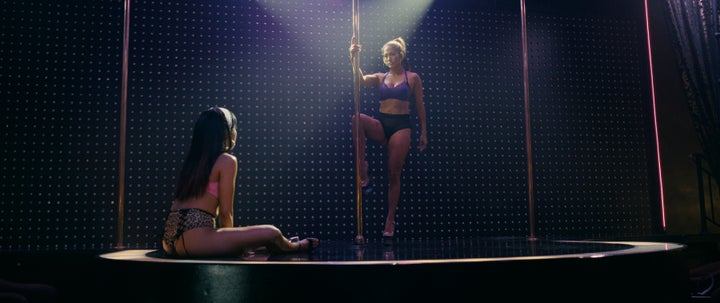Women and girls around the world are being ill-served by portrayals of female leaders told from the “male gaze,” according to a new study being released Tuesday, which the researchers say is the first global study of how women leaders are represented on-screen.
Female lead characters in major movies are more likely to be objectified, perpetuating harmful stereotypes for women and girls, the study found. These portrayals are tied to a lack of women working as directors, writers and producers, and in other behind-the-camera roles, the researchers argued.
The study, called “Rewrite Her Story,” is a collaboration between British-based humanitarian organization Plan International and the Geena Davis Institute on Gender in Media, founded by the actor Geena Davis, who has long advocated for more equitable representation of women on-screen.
The researchers reached their findings through technology called the Geena Davis Inclusion Quotient, a tool that uses facial and voice detection software to analyze female representation in movies and TV shows. The tool ran through the 56 highest-grossing movies released in 2018 in 20 countries, including the U.S., Canada, India, Japan, Germany, Peru and Senegal.
It found that the women portrayed in leadership positions were more likely to depicted as sexual objects or with nudity, compared with their male counterparts, representing how movies are often told from the “male gaze.”
“Our most popular films are sending the message that leadership is primarily a male domain,” the researchers wrote. “Women leaders are subject to the male gaze and not really ‘in charge.’”
“These films show a world which is run by men, for men."”
- “Rewrite Her Story,” a study on representation of female leaders in major movies
Female leaders were more than four times as likely “to be shown wearing revealing clothing” — 30% of them, versus only 7% of male leaders in the movies analyzed in the study.
The women in the 56 films were also almost twice more likely “to be shown as partially nude” than men (15% versus 8%), and four times more likely to appear “completely naked” on screen (2% versus 0.5% of male characters).
The study also found that the women portrayed in these movies were almost four times more likely to be sexually objectified — for example, “the camera focused on their body parts in slow motion” — and five times more likely to be sexually harassed than the men.
The study’s key recommendation for making female leadership “visible and normal” and not objectifying women on-screen: Hire female filmmakers and champion their work.
“These films show a world which is run by men, for men,” the researchers wrote, pointing out that “the filmmakers, too, are predominantly male.”
Among the films that the researchers analyzed, none of them were directed by a woman, only a quarter of them had at least one female producer, and only 1 in 10 of them were written by at least one woman.
The study’s findings are consistent with other studies that have shown the importance of women and girls being presented as leaders on-screen and the lack of women directing Hollywood’s biggest movies.
Thanks in part to the Me Too movement, movie and television creators have slowly begun to scrutinize and be more mindful of the way women are portrayed, with some positive results.
For example, the recent box office hit “Hustlers,” written and directed by Lorene Scafaria and starring Constance Wu and Jennifer Lopez, follows a group of strippers who scammed their Wall Street clients after the 2008 financial crisis. It treats the women at its center with nuance, depicting their complicated relationships and motivations, rather than portraying them one-dimensionally, and the film avoids using a leering gaze when showing their bodies.
Similarly, the recent Netflix limited series “Unbelievable,” which documents several investigations into sexual assault, has earned praise for not sensationalizing the sexual assault incidents rather than focusing on the women at the center of the story.

As part of the study, the researchers also interviewed girls and women ages 15 to 25 in some of the 20 countries on how they see women represented in movies, television and advertising. Many reported feeling discouraged by seeing women often in domestic roles, as sidekicks or as romantic interests to male lead characters.
“Even if I know I could be a leader, I won’t do it because I see it is just for men, not for women,” a 22-year-old woman from Uganda told the researchers. “So that affects me. I’ll have to sit back and watch men doing it, even though I am capable of doing it too.”
“Females aren’t in the top leadership positions almost anywhere in the world, and... even female representation in politics is much lower than men, and I think that sort of translates onto our entertainment,” an 18-year-old woman from Canada told the researchers. “And I think it creates this vicious cycle.”
Many respondents also pointed out that in addition to not seeing enough women leaders on-screen, they also saw a lack of diversity in race, sexuality and economic class.
The researchers also interviewed female filmmakers about their experiences, with many expressing cautious optimism that more women getting opportunities to create movies and television, and employing more women in behind-the-camera roles will lead to better female representation on-screen.
“This is the start of a very exciting time for women filmmakers and I can only hope that this wave for change remains powerful and effective. It is so necessary for female artists to speak out and to speak in unison especially in our current political climate,” Ash Mayfair, a filmmaker from Vietnam, told the researchers, adding that a related issue is equal pay for women. “Economic support for women at all levels is the most powerful tool to achieve gender equality. We have to create jobs for women.”